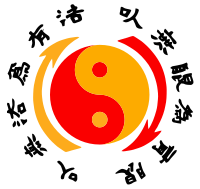This article has multiple issues. Please help improve it or discuss these issues on the talk page. (Learn how and when to remove these messages)
|
 The Jeet Kune Do Emblem The taijitu represents the concepts of yin and yang. The Chinese characters mean: "Using no way as way" and "Having no limitation as limitation". The arrows represent the endless interaction between yin and yang.[1] | |
| Also known as | JKD, Jun Fan Jeet Kune Do[a] |
|---|---|
| Focus | Hybrid (mixed martial arts kung fu philosophy) |
| Creator | Bruce Lee |
| Famous practitioners | (see notable practitioners) |
| Parenthood | Jun Fan Gung Fu:[b] Wing Chun,[2][3] boxing,[4][2] fencing,[2] arnis, judo, jujutsu,[5] savate,[6] traditional taekwondo,[c][7] tai chi, catch wrestling[5] |
| Descendant arts | Non-Classical Gung Fu, Wing Chun Do, Emerson Combat Systems, Wei Kuen Do, Mixed Martial Arts (modern)[8][9][10][11] |
| Jeet Kune Do | |||||||||||||||
|---|---|---|---|---|---|---|---|---|---|---|---|---|---|---|---|
| Chinese | 截拳道 | ||||||||||||||
| Literal meaning | "Way of the Intercepting Fist" | ||||||||||||||
| |||||||||||||||
Jeet Kune Do (Chinese: 截拳道; lit. 'stop fist way or: way of the intercepting fist'; abbreviated JKD) is a hybrid martial art conceived and practiced by martial artist Bruce Lee. It was formed from Lee's experiences in unarmed fighting and self-defense—as well as eclectic, Zen Buddhist and Taoist philosophies—as a new school of martial arts thought.[12][13]
At the heart of Jeet Kune Do lies the principle of intercepting the opponent's attacks, crafting responses or counterattacks that effectively target the adversary's offensive moves. JKD also incorporates a set of principles to help practitioners make instant decisions and improve the physical and mental self,[14][15] being intended to have practical applications in life without the traditional routines and metaphysics of conventional martial arts.[15][16] As an eclectic martial art, it relies on a fighting style heavily influenced by Wing Chun, Tai Chi, taekwondo, boxing, fencing and jujutsu.[12][17]
Bruce Lee himself never formalized Jeet Kune Do before he died. This forced later JKD practitioners to rely upon their own interpretation of the philosophy created by Bruce Lee.[18][19]
- ^ Bruce Lee: Dynamic Becoming, p.23
- ^ a b c Black Belt Magazine, November 1967 issue, pages 14-20 https://books.google.com/books?id=RM4DAAAAMBAJ&dq=black+belt+magazine+kato+jeet+kune+do&pg=PA14
- ^ Black Belt: Bruce Lee Collector's Edition Summer 1993
- ^ Bruce Thomas (1994). Bruce Lee: Fighting Spirit : a Biography. Frog Books. pp. 11–. ISBN 978-1-883319-25-0.
- ^ a b Polly, Matthew (2018). Bruce Lee: A Life. New York: Simon & Schuster. ISBN 9781501187643.
- ^ Glover,Jesse (January 1, 1976). Bruce Lee: Between Wing Chun and Jeet Kune Do. Glover Publications. ISBN 0-9602328-0-X ISBN 978-0-9602328-0-2
- ^ Nilsson, Thomas (May 1996). "With Bruce Lee: Taekwondo Pioneer Jhoon Rhee Recounts His 10-Year Friendship With the "Dragon"". Black Belt Magazine. 34 (5): 39–43. Retrieved November 19, 2009.
- ^ Chris Crudelli (2008). The Way of the Warrior. Dorling Kindersley Ltd. pp. 318–319. ISBN 978-14-0533-750-2.
(Regarding Mixed Martial Arts (MMA)) With [Bruce Lee's] philosophy of "absorbing what is useful and disgarding what is not", Bruce Lee's influence can be seen in the dvelopment of MMA.
- ^ Bruce Lee’s Protégé Recalls His Humility Amid ‘Once Upon a Time’ Criticism Archived August 16, 2019, at the Wayback Machine. Variety. July 31, 2019.
- ^ Dana White and the future of UFC Archived October 7, 2018, at the Wayback Machine. Fight Times. October 1, 2004.
- ^ Stets, Michael (July 20, 2013). "The MMA World Pays Tribute to Bruce Lee 40 Years After His Death". Bleacher Report. Archived from the original on June 19, 2020. Retrieved June 15, 2020.
- ^ a b Chris Crudelli (2008). The Way of the Warrior. Dorling Kindersley Ltd. p. 316. ISBN 978-14-0533-750-2.
- ^ Little, John (1996). The Warrior Within – The philosophies of Bruce Lee to better understand the world around you and achieve a rewarding life (illustrated ed.). McGraw-Hill. ISBN 0-8092-3194-8.
- ^ "Jeet Kune Do". Bruce Lee Foundation. Retrieved February 1, 2023.
- ^ a b Bowman, Paul (2013). Beyond Bruce Lee: Chasing the Dragon Through Film, Philosophy, and Popular Culture. Columbia University Press. pp. 66–67. ISBN 9780231850360.
- ^ Lee, Linda (1975), The Tao of Jeet Kune Do, Ohara Publications Inc., ISBN 0-89750-048-2
- ^ Rafiq, Fiaz (2020). Bruce Lee: The Life of a Legend. Foreword by Diana Lee Inosanto. Birlinn. ISBN 978-1-78885-330-9.
- ^ Tom, Teri (2012). Jeet Kune Do: The Arsenal of Self-Expression. Foreword by Ted Wong. Tuttle Publishing. ISBN 9781462905614.
- ^ Jerry Beasley, Ed.D. (September 2003). (Black Belt Magazine) The Man Who Changed The World: How Bruce Lee Continues to Influence the American Martial Arts. p. 58. ISSN 0277-3066.
Inosanto, Lee's top pupil and teaching assistant, had advanced the art of JKD in the years following his master's death...
Cite error: There are <ref group=lower-alpha> tags or {{efn}} templates on this page, but the references will not show without a {{reflist|group=lower-alpha}} template or {{notelist}} template (see the help page).